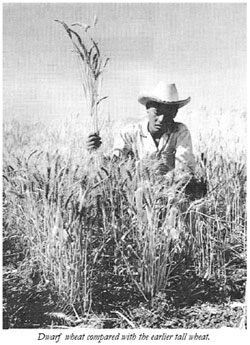|
Third Innovation: Changing the Wheat Plant’s
Architecture
Mexico’s wheat varieties were naturally slender and
inclined to be tall. None of the varieties was capable
of efficiently using heavy applications of fertilizer to
increase yields. When fertilized they grew tall and
rank; with wind at the time of irrigation or with rain
they fell flat on the ground. Thus, more fertilizer
often meant less grain per hectare. As the use of
fertilizer increased and yields climbed to 4,500 kilos
per hectare, lodging—the tall wheat plants heavy with
grain falling over before ripening— began to limit
further increases in yields. Borlaug began a search for
wheat from different areas of the world to locate a
suitable source of genetic dwarfness to overcome this
barrier. He grew more than 20,000 lines, but found none
with short, strong stems.
 In
late 1952, Dr. Orville Vogel, a prominent US Department
of Agriculture wheat breeder stationed at Washington
State University, had obtained preliminary successes in
crossing a Japanese dwarf winter-habit wheat with his
tall US winter wheats. Vogel had obtained a sample of
the Japanese dwarf wheat seed—Norin 10—from a USDA
agricultural advisor who was serving in Japan after
World War II. The advisor had sent the seeds back to the
USDA, which distributed them to several American wheat
scientists, including Vogel, in 1948. In
late 1952, Dr. Orville Vogel, a prominent US Department
of Agriculture wheat breeder stationed at Washington
State University, had obtained preliminary successes in
crossing a Japanese dwarf winter-habit wheat with his
tall US winter wheats. Vogel had obtained a sample of
the Japanese dwarf wheat seed—Norin 10—from a USDA
agricultural advisor who was serving in Japan after
World War II. The advisor had sent the seeds back to the
USDA, which distributed them to several American wheat
scientists, including Vogel, in 1948.
When
Borlaug learned about these short-strawed wheats, he
embarked on a third major innovation. In 1953, he
obtained a few seeds from Vogel’s most successful lines
and began crossing them with the most promising, broadly
adapted Mexican varieties. A new type of wheat—short and
stiff-strawed instead of tall and slender—began to
emerge. The progeny of the Japanese short wheat tillered
profusely, thrusting up more stems from the base of the
plant than western wheats, and it had more grains per
head. A series of crosses and re-crosses gave rise to a
group of so-called dwarf Mexican wheat varieties. The
potential yield of the new varieties, under ideal
conditions, increased from the previous high of 4,500
kilos per hectare to 9,000 kilos per hectare. [...]
The
dwarf Mexican wheats were first distributed in Mexico in
1961 and the best farmers began to harvest five, six,
seven, and even eight tons per hectare. Within seven
years, the national average yields had doubled. Borlaug
named two of the best strains Sonora 64 and Lerma Rojo
64. It was these same dwarf Mexican wheats derived from
the early days of Borlaug’s transformative efforts that
would later serve as catalysts to trigger the
Green Revolution in India and Pakistan.
Borlaug’s remarkable achievement in so few years was
rare. Advances in agriculture typically are gradual. In
describing the event, Don Paarlberg, who at the time was
Director of Agricultural Economics in the office of the
Secretary, US Department of Agriculture, wrote: “Several
things about this breakthrough made it special, gave
it particular significance. It came in the hungry part
of the world, not in those countries already surfeited
with agricultural output. It came in the semi-tropics,
which had long been in agricultural torpor, not in the
temperate climates, where change was already occurring
at a pace more rapid than could readily be assimilated.
It produced new knowledge and technology that could be
used by farmers in small tracts of land, rather than
being, like many technological changes, adaptable only
on large farms. And it was a breakthrough that came
voluntarily, up from the grass roots, rather than being
imposed arbitrarily from above.”
|